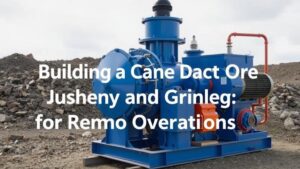How to Construct Underground Ore Hoppers for Efficient Loading
How to Construct Underground Ore Hoppers for Efficient Loading
Underground ore hoppers play a crucial role in the mining industry by facilitating the efficient loading of mined materials for transportation. This article explores the essential components and considerations for constructing these hoppers, ensuring they meet both operational efficiency and safety standards.
Understanding the Purpose of Ore Hoppers
Ore hoppers are designed to store and manage the flow of ore before it is transported to the surface or processing facilities. Their benefits include:
- Minimizing transportation delays
- Reducing the risk of ore spillage
- Streamlining the loading process
Properly constructed hoppers can significantly impact operational efficiency and contribute to the overall productivity of a mining site.
Key Components of Ore Hoppers
Constructing an underground ore hopper requires careful consideration of several key components:
- Mouth Opening: The entrance where ore is fed into the hopper must accommodate the size and characteristics of the ore. Common dimensions for mouth openings vary based on the type of ore and the surrounding conditions.
- Capacity: Hopper capacity is directly linked to the volume of ore being processed. A larger capacity can boost efficiency, but it may also complicate construction.
- Material and Design: Hoppers are typically made from high-strength steel to withstand abrasive materials. The design should incorporate both the physical stresses involved and the flow dynamics of ore.
- Drainage System: Adequate drainage is essential to prevent the buildup of moisture, which can lead to material clumping and hinder operations.
Design Considerations for Construction
When designing and constructing an underground ore hopper, consider the following factors:
- Geological Survey: Conduct a detailed geotechnical analysis to understand the rock type, moisture levels, and overall stability of the surrounding ground.
- Flow Dynamics: Employ engineering principles to predict how ore will flow through the hopper. Techniques such as computational fluid dynamics (CFD) can help optimize the internal geometry.
- Access and Maintenance: Design hoppers with easy access points for maintenance to ensure efficiency and safety during operations.
Construction Process: Step-by-Step
The construction of an underground ore hopper typically follows these steps:
- Site Preparation: Clear the construction area of any surface debris and ensure stability in the surrounding geology.
- Excavation: Dig to the required depth while maintaining the integrity of surrounding soil and rock formations.
- Formwork Installation: Set up formwork to dictate the desired shape and capacity of the hopper.
- Reinforcement: Use steel reinforcing bars to enhance the structural integrity of the hopper structure.
- Concrete Pouring: Once formwork and reinforcement are in place, pour high-strength concrete to create a durable hopper structure.
- Finishing Touches: Install the drainage system, and ensure all connections and interfaces are sealed and functional.
Real-World Applications and Case Studies
Several mining companies have adopted innovative designs for underground ore hoppers. For example, Barrick Gold’s Pueblo Viejo mine in the Dominican Republic utilizes advanced underground wear-resistant materials in their hoppers, resulting in reduced maintenance costs and increased ore throughput.
In another instance, the BHP Olympic Dam in Australia implemented a modular hopper design that allows for quick assembly and disassembly. This design not only preserves flexibility for future expansions but also expedites maintenance processes.
Conclusion and Actionable Takeaways
Constructing effective underground ore hoppers demands rigorous planning, engineering expertise, and an understanding of operational dynamics. By focusing on these key elements–capacity, design, material choices, and construction processes–mining operations can achieve significant reductions in operational downtime and increased efficiency.
Mining engineers and site managers should consider the following actionable steps:
- Conduct thorough site assessments and geological surveys prior to construction.
- Use advanced design technologies, such as CFD, to optimize hopper functionality.
- Regularly review and maintain hopper conditions to prevent operational failures.
By adhering to these guidelines, mining operations can maximize productivity and ensure sustainable practices in the management of ore loading.


